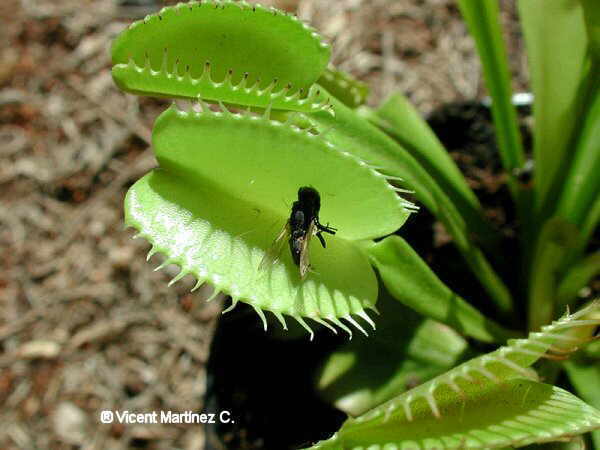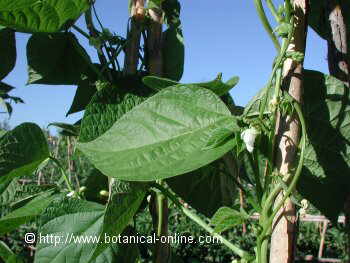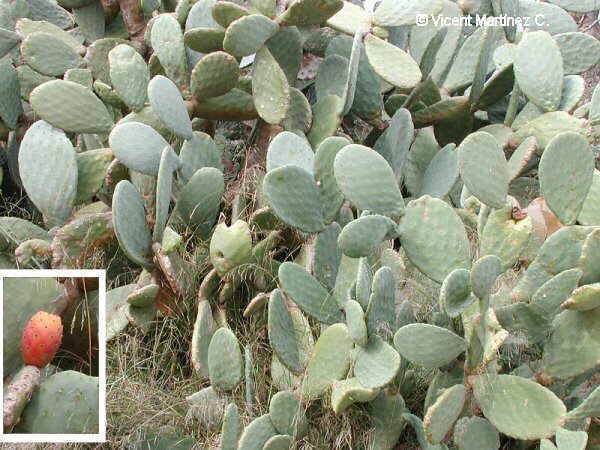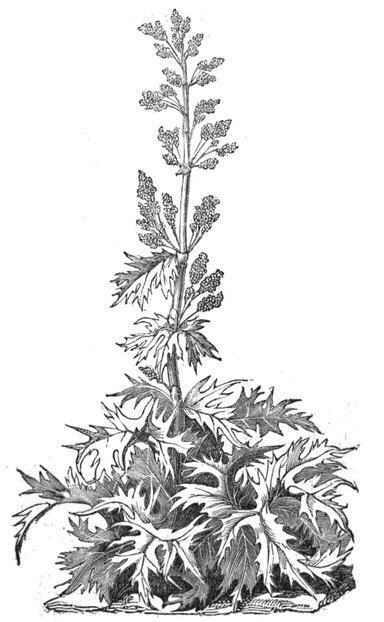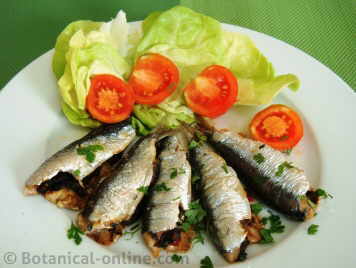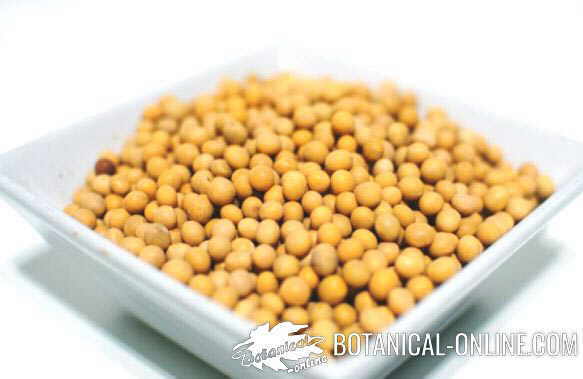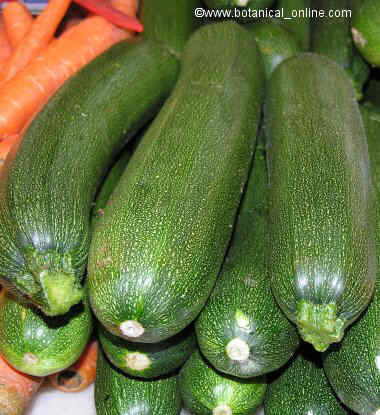How to grow Ribes rubrum / Ribes nigrum
Currant care
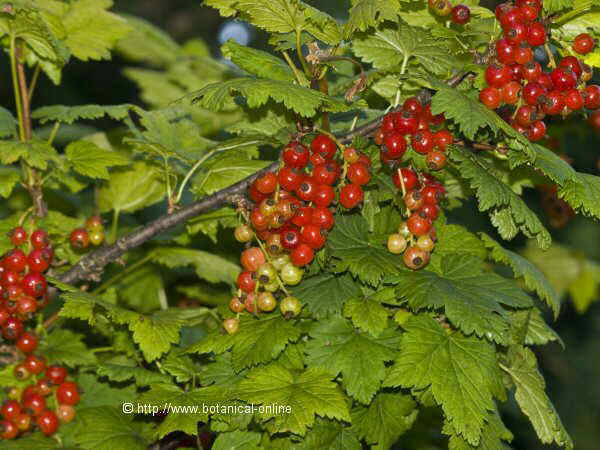
Redcurrant photo (Ribes rubrum)
 Currants characteristics
Currants characteristics
A currant is a plant of the Saxifragaceae family
Red currants (Ribes rubrum) are deciduous shrubs between 1.5 and 1.8 m in height by about half a meter wide. Thornless stems, palmately-lobed leaves with a distinctive odor when being rubbed and with dense white hairs on the underside. Currant leaves are simple and have up to 5 lobes provided with teeth on the margin.
Flowers appear in spring in inflorescences composed of numerous hanging clusters of inconspicuous whitish green. Their fruits are edible berries, also called currants, which ripen in summer. They have a very distinctive sour taste and a bright red or amber color. Sometimes they present a translucent pale yellow color. In this case, they are known popularly as white currants
Black currants (Ribes nigrum) differ from red currant because of the color of their fruits and because a black currant plants looks less tall and wider. Its leaves are more aromatic by the presence of yellow-secreting glands located on the underside. Its flowers have reddish tones inside. The fruits are edible and have properties similar to those of red currant, although more intense. With this bush liqueur of blackcurrant is made.
 Currants. Watering
Currants. Watering
Abundant when planting them and during growing. Also they have to be often watered when they bloom in the spring or when fruiting in summer.
Currant plants have shallow roots so the best way to water them is through the drip system that maintains soil moisture without it becoming flooded. Currants need good drainage to avoid stagnation which causes the onset of some disease, especially mildew. Once past the fruit production, reduce watering
 Currants. Uses
Currants. Uses
Currants are planted primarily for the production of fruits. In this case, we have small family plantations carried out on patios or private gardens or intensive plantations aimed at higher production.
Currants can also be planted as ornamental plants for the beauty of its fruit bunches and the fineness of its leaves, especially some ornamental varieties that are used to form hedges or decorate rocky slopes. Within these varieties we have, for example, Buffalo currant (Ribes odoratum), with lobed leaves that take on a golden yellow color in autumn that makes this plant very decorative. Other shrubs that are grown for their decorative properties are flowering currant (Ribes sanguineum) or fuchsia-flowered gooseberry (Ribes speciosum)
Blackcurrants are more widely used than redcurrants. In addition to being used as fruit and because of their medicinal uses, blackcurrants are used for the manufacture of vodka, which they provide color and flavor to. Also used in the production of certain beers, ciders or French liqueur Creme de cassis (blackcurrant Creme), to produce oils, dyes, etc..
It is also possible to grow currants in large containers. However, we must bear in mind that these are no longer beautiful after collecting the fruits. In this case, the container must maintain a degree of moisture throughout the whole year.
 Currants. Where to plant them?
Currants. Where to plant them?
Currant bushes grow best in cold regions with humid summers and very cold winters. They prefer to be exposed to the morning sun, better than the afternoon, when they require a little shade. Currants do not withstand temperatures over 29 º C. When the ambient temperature exceeds this figure, their leaves are burned and the plants wilt.
Moreover, these plants are very hardy. (Black currants, which are more sensitive to cold than the red ones, can withstand temperatures of -20 º C, although the flowers fade at -2 º C)
Currants prefer good air circulation, but they do not do go on well with the wind, so they should be planted in a sheltered place, especially blackcurrants that require superior protection and more heat. Wind currents that carry sea salt will burn and will spoil the plant leaves.
 Currants. Planting and reproduction
Currants. Planting and reproduction
Reproduction of currants is best carried out in the fall or early winter.
Prior to this, it is required to prepare the soil with a shallow plowing or a prior weeding by hoe to remove weeds and turn the soil. We must prepare the holes in which the soil resulting from digging the plot is mixed with manure . Normally the holes of the same row are separated 1 or 2 meters, while a distance of 1.5 meters is usually left between row and row. The holes are marked by stakes.
Once the soil is prepared, plantation, as in most of fruit trees, can be performed using appropriate techniques for this type of plant. We have the following methods:
- By seedlings: (we should use grafted nursery copies of one or two years old and with a certification origin). Ideally, the grafted seedlings are kept in water for a few hours before planting or are introduced into the goo. They should be revised to cut those roots that are in bad shape and cut all the branches that grow below the grafting point (suckers).
The soil holes must be opened again and covered with soil that is tamped around the roots. Once fully seated in the hole, stems are cut in half and a hole left around to collect rainwater or irrigation.
- By seeds: Seeds are planted in autumn in a cold seedbed. Previously, they should be stratified for about three or four months with temperatures between 0 º C and 3 º C. later, they will be planted in individual containers that will be preserved indoors during the winter.
In the spring or early summer, they can be transplanted into its final place. The fruiting takes place when the bushes is 3 or 4 years old. The fruit quality of the copies made from seeds is very similar to the sample from which these came, so they do no need to be grafted.
- By hardwood cuttings (one year old cuttings will be taken) Cuttings are obtained in winter. They should be about 30 cm long. Cut the branches of shrubs, Discard the soft material and preserve the hard one.. To produce roots, they are introduced in growth and, later, they are soil planted. During the first year, they are left inside in the shade in order for them to develop roots. Then, the following year, they are transplanted into its final place.
In warmer places, cuttings can be planted directly on the ground in fall. For them, dig a trench about 20 cm deep. Subsequently add gravel to the bottom and fill the trench with a mixture of soil and dung. Once the ground is prepared, take a branch of 1 year old and remove its tender top, making a slanted cut just below a bud. Cut the harder inferior part to obtain a cutting about 30 cm log. Remove the buds that have to be buried, introduce them on the soil of the trench so that about three buds remain above ground. The bud closer to the floor should be a minimum of 5 cm. After securing the plant by gently pressing the soil, irrigate it. The seedlings can be transplanted after one year. You have to keep the soil weed free and with good moisture conditions.
New plants produced by cuttings do not need to be grafted because the graft will not produce fruits with a greater quality.
 Currants. Care and pruning
Currants. Care and pruning
Besides keeping the soil moist at appropriate times, you must also keep it free of weeds. This requires weeding the soil between plants above and then, not to hurt the roots that grow superficially. It is better to remove the weed around shrubs manually
A good way to prevent grass growing and maintain a constant level of humidity is quilting the ground in spring.
How to prune red currants?
Formation pruning: Redcurrant pruning takes place during the first three winters. It is very convenient to prune currants during the first three years to ensure that the fruits grow on the most productive branches (branches of two to three years old). To do this, in the first year, all branches except three will be pruned at ground level. In the second year of growth, prune all branches at ground level, except two young branches and those three ones that grow in the first season. In the third year, we cut all new but two young branches and 5 or 6 of the previous seasons.
Maintenance pruning: From the fourth season on, we should begin to perform a maintenance task: all young branches are cut except two, also those more than three years old and one of two years. In this manner fruits will be produced mainly in most branches of two to three years of age
Maintenance also implies pruning too long branches, dead ones or damaged. Secondary branches are cut leaving only about 5 cm so that the plant, especially the center of them, remain clear, which facilitates aeration and maintenance chores.
How to prune black currants?
Pruning in blackcurrants is different from that of redcurrants because blackcurrant fruits appear on the young branches of the same year. So after picking the fruits, these should be pruned completely so as they can develop new branches for the new season.
 Currants. soil and fertilizer
Currants. soil and fertilizer
Currants can grow in any soil except excessively acidic or alkaline. The prefer slightly acidic soil with a pH between 6.5 and 6.8.
Sandy soils or limestone are not very convenient because they retain some moisture. They do not tolerate saline soils or those with poor drainage (too clayey). The best soil has to be rich in marl, with a good amount of organic matter.
Fertilizer has to be added in the preparation of the ground. If the soil has been prepared with plenty of manure, they will not need to be fertilized later. Keep in mind that black currants require more manure than red ones.
In extensive production add 1.35 Tm of nitrogen per hectare per year. Excess of nitrogen can facilitate the emergence of diseases. It may also be necessary to add potassium to avoid burning the leaves. In this case it is recommended about 170 kg per hectare. Avoid potassium chloride.
 Currants. Collecting and preserving
Currants. Collecting and preserving
Currants in Europe are collected during the months of June, July and August depending of the different varieties. If you want to eat the ripe fruits directly from the plant, it is best to leave them about three weeks in the same plant after they have colored. When collecting it is best to avoid moisture and do it when they are completely dry.
Production of each shrub depends on each class or variety but it generally varies between 1.4 and 4.5 kilos.
Bunches must be collected complete and then separate the berries with a fork. Although they can hold out until a week or two in the fridge, you better prepare them as jam alone or combined with other fruits like raspberries. You can add a few pieces of freshly picked apple tree with their skin to reduce its acidity and help them to thicken.
![]() More information about redcurrants.
More information about redcurrants.

 Currants. Watering
Currants. Watering Currants. Collecting and preserving
Currants. Collecting and preserving